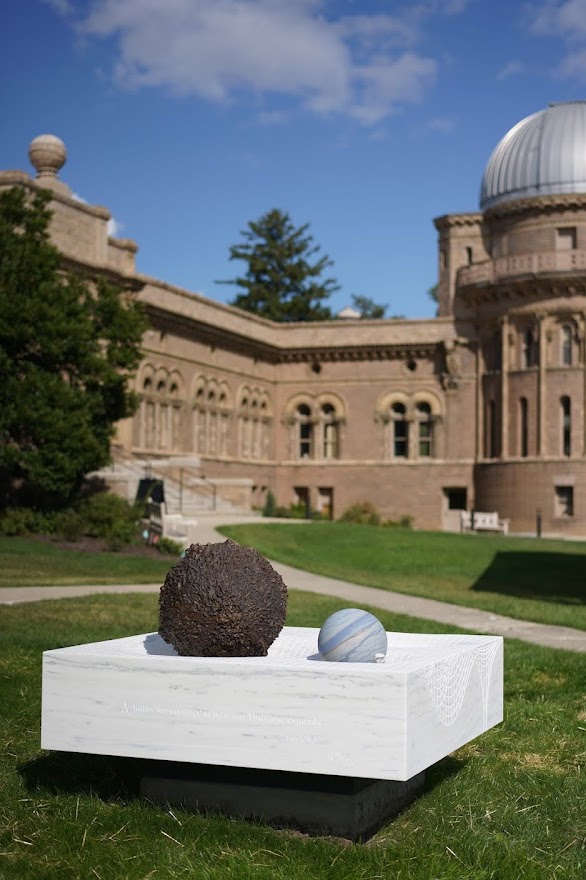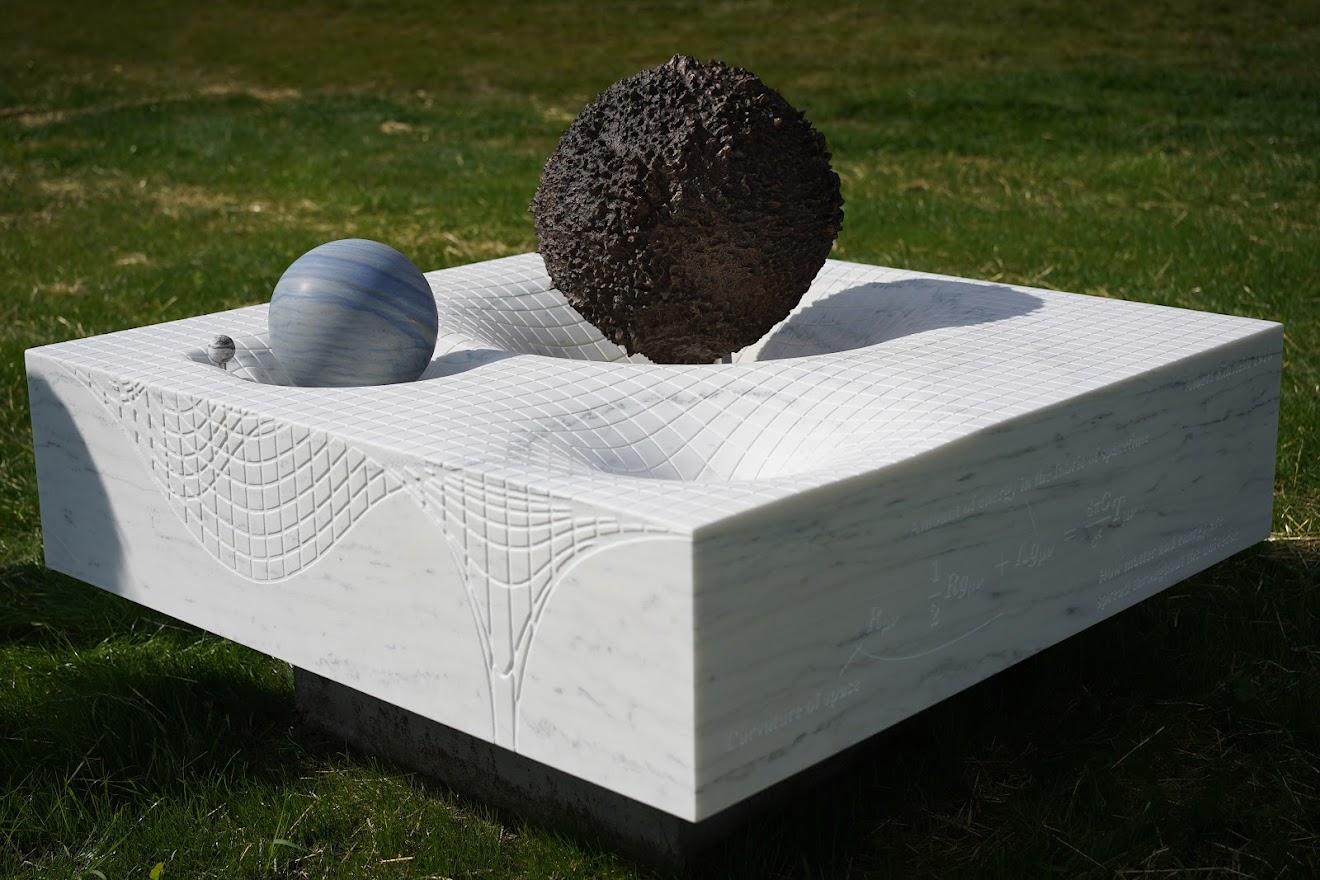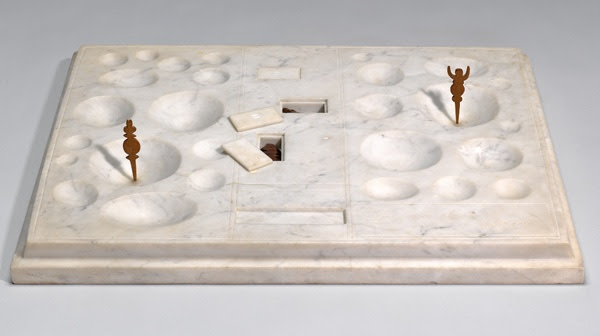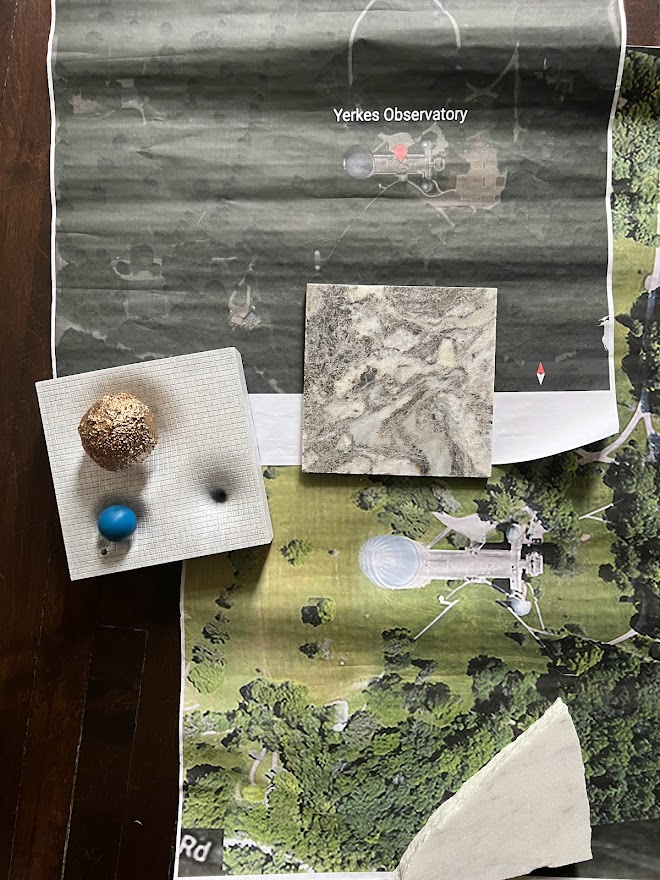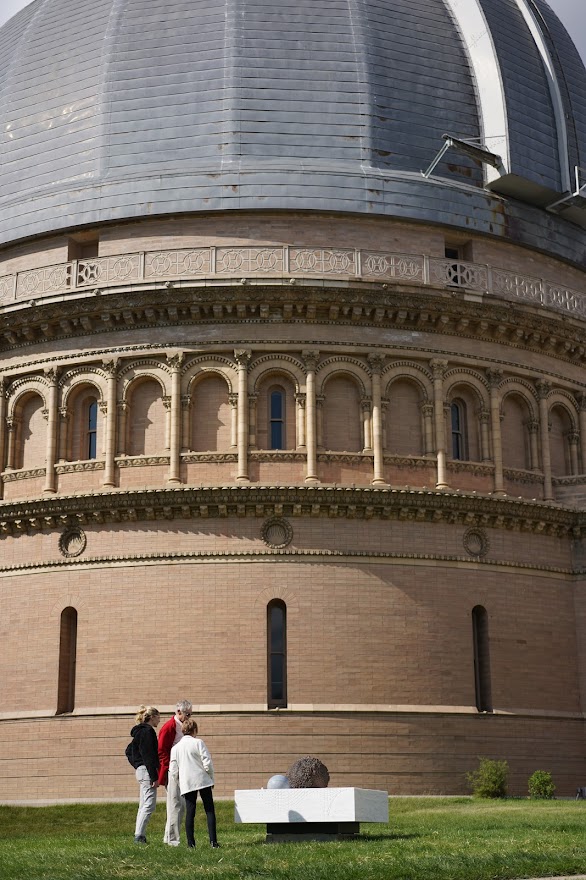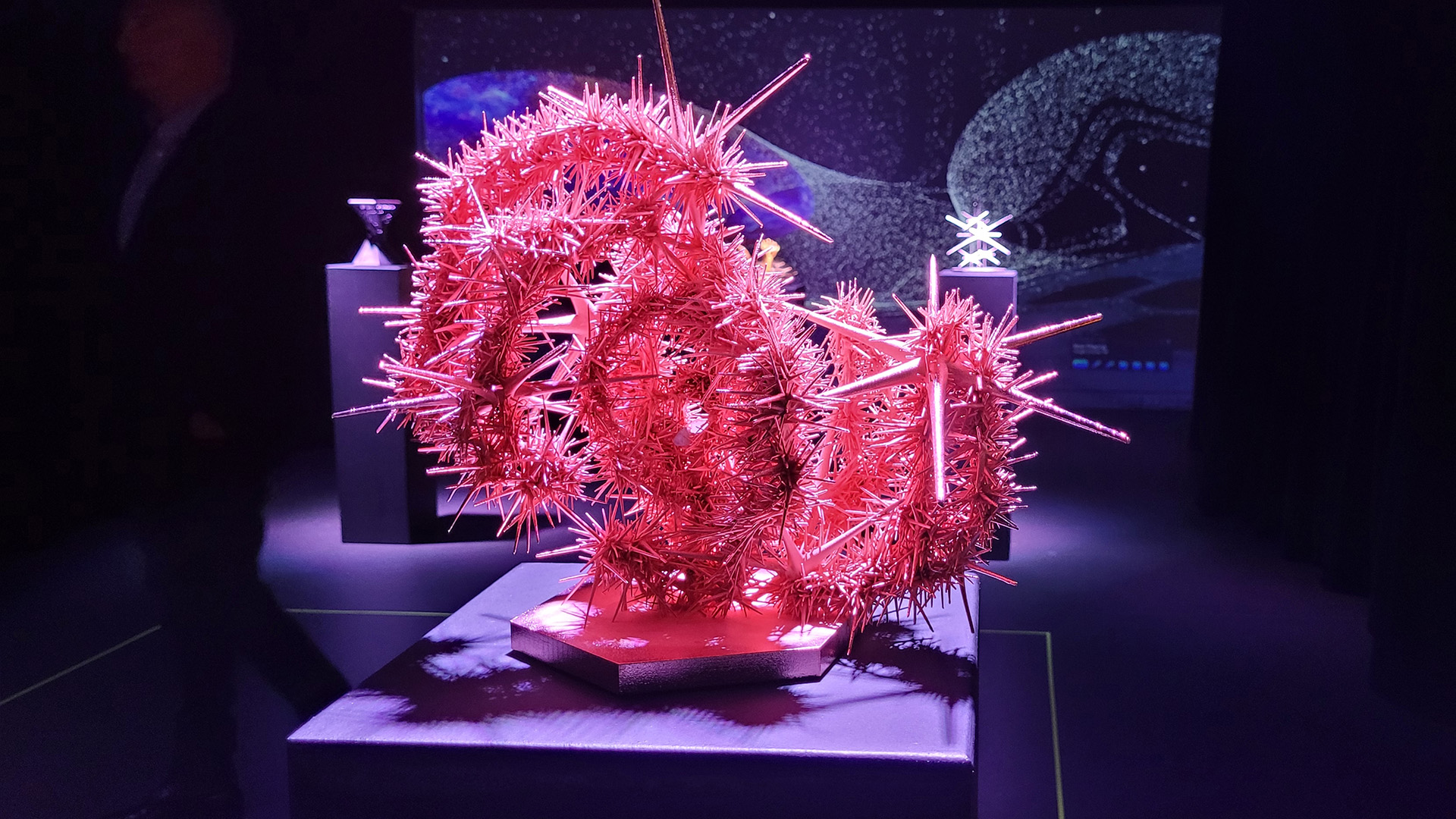The artist who sculpted the 4-dimensional fabric of space and time
"Sometimes I feel intimidated by the beauty of these discoveries in science just because they are already so perfect."
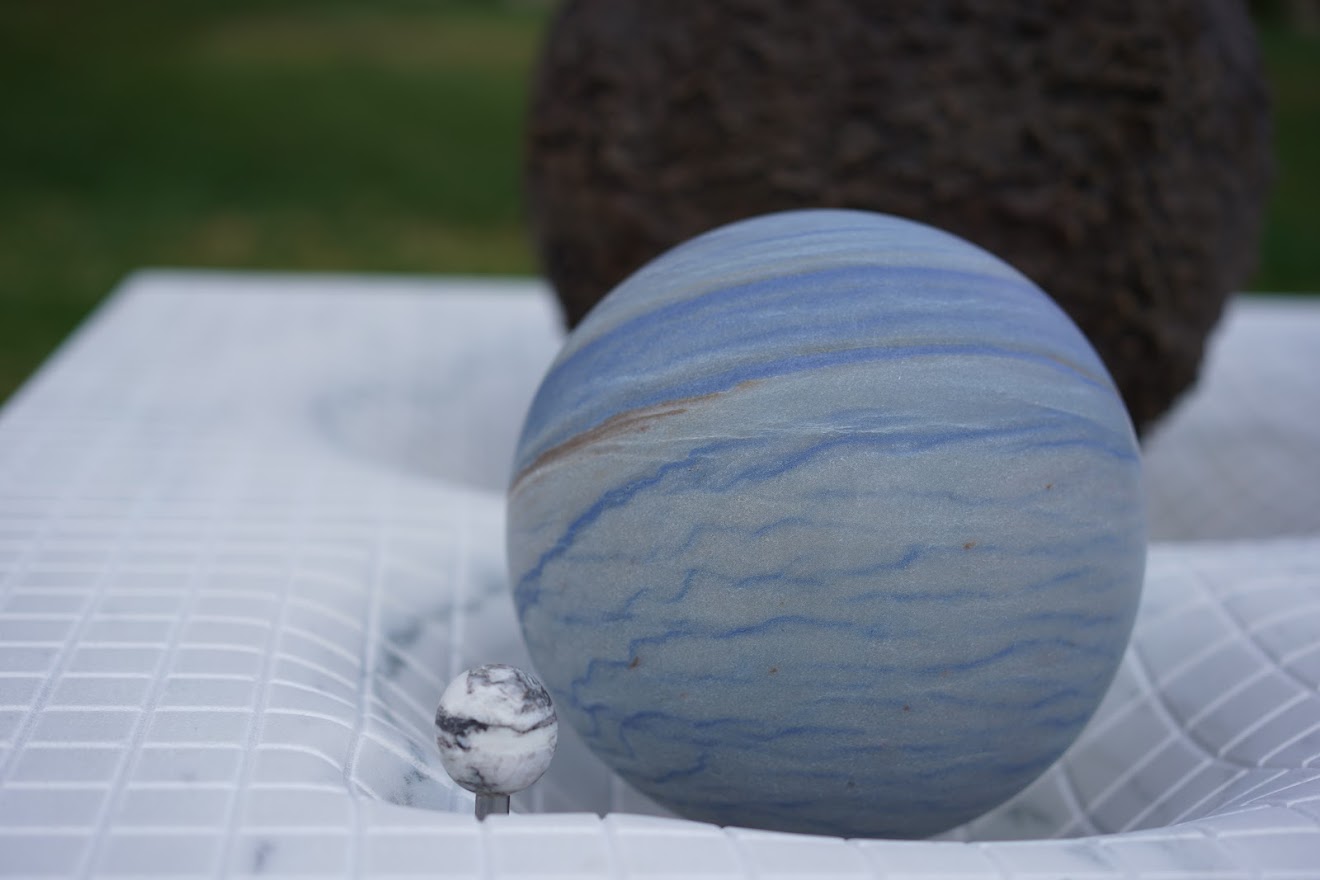
Outside the Yerkes Observatory, a gravitationally warped slice of our universe sits in the grass.
This distorted block wasn't transported to our planet from the depths of outer space, however; it comes from the mind of Ashley Zelinskie, whose mission it is to take elusive intricacies of the cosmos and turn them into fine art.
"I kind of like to be the scientific artistic translator," she said, "taking it from one language to another."
An homage to both the historic institution and general relativity's founding father, Albert Einstein, Zelinskie's molded marble prism is forged with four buttery divots to represent an existential truth about our universe — that space is far more than the space we live in, and time is far more than the rhythm we live by.
"Art and science and religion and music are all just humans trying to figure out their place in the universe," Zelinskie said. "We shouldn't feel like we have to separate science and art so much. They don't need to be so polar opposite."
As Einstein outlined in 1915, space is something like an elastic sheet of 4D fabric threaded together by forces of nature and disturbed by entities lying within. This fabric, which cannot ever be seen by human eyes, gets warped by anything that has mass. And yes, that includes you and me. It's just that more massive warps result from more massive items — stars warp space-time a lot, planets do a solid amount and moons do a little bit, yet the warps we create are indiscernible. And in fact, it is these warps that dictate how objects in our universe travel, ultimately giving rise to what we perceive as gravity.
Per general relativity theory, there isn't a mysterious tug pulling you to the ground. You're just falling along a warp of space-time created by Earth, and Earth is simultaneously stopping your fall. It's confusing to imagine, of course, because we're trying to conceive of the notion in 3D, but it exists in 4D.
Breaking space news, the latest updates on rocket launches, skywatching events and more!
American physicist John Archibald Wheeler once described how to think about it with a simple sentence: "Space-time tells matter how to move; matter tells space-time how to curve." And with her new sculpture, Zelinskie gives us a shining new way to visualize it.
"I want it to be off-putting; I want it to be unsettling," said Walt Chadick, Director of Programs and External affairs at the Yerkes Observatory in Williams Bay, Wisconsin. "Simultaneously, I want it to be comforting and engaging."
It's one thing to visit an observatory and consider the science that's been done there, but wholly another to stumble upon a clear representation of what those cosmic calculations, hypotheses and ideas are really saying.
Physicists are so enamored with the stars hanging above us because they are truly above us; Einstein thought so deeply about the fabric of space-time because it's the fabric we live in.
"You need to break through to the other side of that existential crisis where you're happy about it because you get to be here; you get to experience reality," Zelinskie said. "How lucky we are to experience this reality, and be a part of this universe, and be made of the same stuff."
Inspired by Alberto Giacometti's neutral-toned "No More Play" game board exhibit from the 1930s, Zelinskie's sculpture presents an antique-looking bronze star, a planet made of rare Brazilian blue quartzite and a soft marble moon seemingly floating above three cavities, each built with the right relative warp size.
"It's very important to be accurate," Chadick said, "because the truth is way more exciting."
"When you're picking out stones to reference a planet, most people immediately think of Earth," Zelinskie said. "So, I wanted it to be a blue planet." Even for exoplanet hunters, she points out, the first thing they hope to find is some sort of azure hue because blue generally means water to us, and water means life (as we know it, at least).
The star is bronze, Zelinskie explained, to reflect old telescope metal found at Yerkes, while the moon looks covered in snow because it's meant to be an icy satellite like Europa — a moon of Jupiter that scientists think holds the tantalizing possibility of sustaining life.
The fourth, final and deepest dip in Zelinskie's structure remains empty, but not because there'd be nothing in the piece's 4D parallel. It's because the entity that'd populate this space is so incomprehensible by the human brain that it's better off left implied. "We have a big black hole just to show an extreme case of the warping of space-time."
While speaking with Zelinskie, I was abruptly awakened from my cosmic dream when she noted that, ironically, the void-based warp proved to be a bit of a practical hazard. "The black hole has to drain," she said.
"We don't want it to fill with water and then become a mosquito pond."
Right near the astronomy golf course
Now home to this representation of 4D cosmic fluidity, the Yerkes Observatory gazed at the night sky for the first time in 1897. Since then, some of the most famous scientists in the world have wandered its ornate halls and harnessed its hefty instruments.
This is where Edwin Hubble photographed seminal evidence that our universe is endlessly expanding and where Carl Sagan and Nancy Grace Roman, NASA's first chief of astronomy and the namesake of a major forthcoming space telescope, did their graduate work. Yerkes was also constructed on an arboretum spanning 50 acres (20 hectares), meaning it boasts serene views and, over the years, has earned itself a few eclectic decorations.
"The astronomers in the early days got bored and had a connection with James Naismith, who had invented basketball," Chadick said. "They hired him to come here and build this six-hole golf course on the property."
But most importantly for Zelinskie's artwork, Yerkes welcomed Albert Einstein in 1921 during his first trip to America.
"The materials were chosen specifically to mirror the builds of this historic building that's made of stone and metal," Zelinskie said. "So, it is in conversation with the architecture and you want it to stay in conversation with the architecture."
Back to the cosmic dream
At the time when Yerkes asked Zelinskie to create an art installation for the observatory's grounds, she'd already had several scientific exhibits under her belt — most notably, an exhibit focused on the James Webb Space Telescope's (JWST) stunning first images.
The $10 billion dollar JWST, packed with powerful infrared-sensing devices and adorned with 18 hexagonal gold-plated mirrors, launched to space on Christmas Day in 2021, embarking on a mission to unveil pieces of the universe hidden to human eyes.
It took a few months for the JWST to settle into its new home about a million miles from our planet, but once it started delivering images, it was unstoppable. But those first few muses — two nebulas, a galactic menagerie, a deep field and a planet that yielded not a visual but a story — will always hold a special place in space enthusiasts' hearts, mine included.
Zelinskie's work, entitled "Unfolding the Universe: First Light," included a striking variety of artistic mediums such as virtual reality, holograms and sculptures reminiscent of her latest general relativity piece at Yerkes. And even though the gallery undoubtedly captured the awe of JWST's sights in aesthetics, it was the details Zelinskie told me about that enhanced them even further.
To name just one, in a 3D-printed sculpture she'd made of the Southern Ring Nebula, there are two aquamarine crystals placed in the center to represent the binary star system this stellar nursery houses. "Aquamarine is derivative," she said. "It comes from beryllium, and the telescope's made of beryllium."
"Sometimes I feel intimidated by the beauty of these discoveries in science just because they are already so perfect," Zelinskie said. "What could I possibly add to it? What comment could I possibly make on it that would make it better than it already is?"
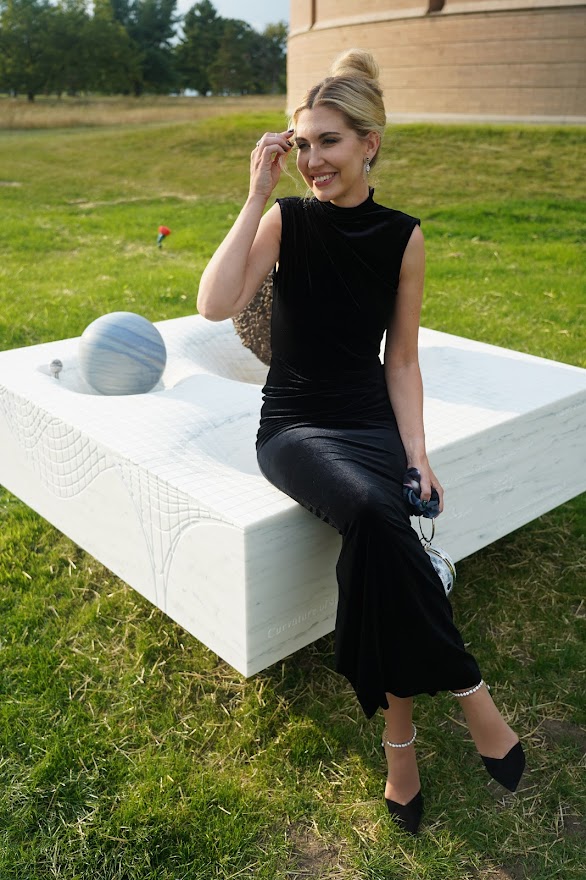
Nonetheless, she finds a way because there is one thing art can do that science cannot. Though numbers and proofs can bring us toward an understanding of our universe, design and words help us interpret that understanding. One of Zelinskie's early inspirations for her technology-focused work was Joseph Kosuth, an American conceptual artist known for his 1965 piece entitled "One and Three Chairs." In it, a physical chair sits alongside a photograph of a chair and the dictionary definition of the word, "chair."
The purpose of One and Three Chairs was to ask the viewer which chair is "real." What does it mean to be real? Zelinskie recreated this concept by 3D printing hexadecimal code for the physical chair Kosuth presented in his exhibit, then piecing together that code in the shape of the original chair. Now, a computer and a human would be seeing this chair in the same way. But, to whom is the "real" chair given?
"What is the true nature of this object?" she asked.
In a similar vein, Zelinskie now forms a bridge between the seemingly unknown fabric of existence and the tangible version we grapple with every day.
"I had a poetry professor named Miller Williams who said art to the viewer or reader needed to feel natural and inevitable," Chadick said, "as if the world couldn't exist without this piece of art now that it's here."
The exhibit is called "Time will Tell."

Monisha Ravisetti is Space.com's Astronomy Editor. She covers black holes, star explosions, gravitational waves, exoplanet discoveries and other enigmas hidden across the fabric of space and time. Previously, she was a science writer at CNET, and before that, reported for The Academic Times. Prior to becoming a writer, she was an immunology researcher at Weill Cornell Medical Center in New York. She graduated from New York University in 2018 with a B.A. in philosophy, physics and chemistry. She spends too much time playing online chess. Her favorite planet is Earth.
